Form follows Function, as we all know… but function can change, leaving the form out of context.
Consider the long, rather dilapidated building with the vaulted, tilting roof seen behind this parking lot in downtown Jerusalem. What does its form tell you?

In its heyday, in the 1940s and 50s, this strange form was dictated by the building’s function: it housed a luxurious, large movie theater, the Orion Cinema. The long, narrow, slanting form was due to the rising rows of seats.
Today these large cinema halls are a thing of the past, driven out of business by home video and the smaller, more modern halls of multi-theater complexes in shopping malls, whose function is not visible externally any more. And the grand old Orion building now houses a McDonalds… whose function has nothing to do with its form either. The younger generation who eat in it have no idea that it was one of their city’s major entertainment venues 70 years ago… and would certainly not recognize the building’s odd shape. Oh well…
In a world of rapidly advancing technology it is the fate of any given product to go down from the latest and greatest to a commodity in a few years. The fancy box my first electronic calculator came in probably cost more to make than an entire calculator costs today – and today’s unit, though far more powerful, is sold in an ignominious blister package…
I found a good illustration of such a trend when putting in order some of the accumulated techno-junk in my basement. A load of old software backups allowed me to view a history of the packaging of a once excellent innovation, the soon to be forgotten 3.5-inch micro-floppy disk.
When these rigid diskettes hit the market in the early eighties, popularized by the original Mac and Amiga computers, they were a great improvement over their flimsier 5.25-inch predecessors. They were also expensive enough to warrant packaging in very nice cardboard boxes, ones that would double as easy to browse diskette libraries. Like this elaborate package by Maxell:

Then prices inched lower, and by the nineties Maxell made the same product in this box, which was a tad harder to flip the disks in but was made of two cardboard parts instead of the earlier three:
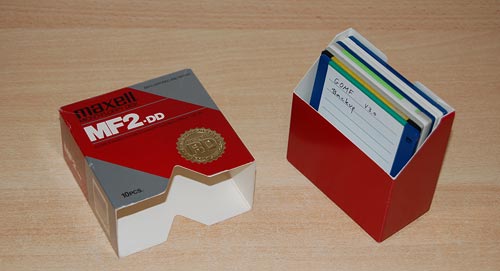
And lastly, in the previous decade and up till their gasping breath when flash sticks drove them out entirely, floppies were downgraded to the cheapest one-piece box type possible, as seen below.
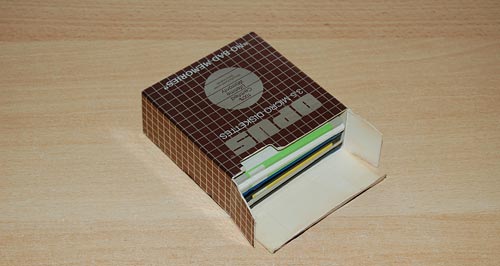
Thus passes the glory of the world…
The “zebra” pedestrian crossing with its rectangular stripes is all too familiar. According to Wikipedia, it was introduced after WW2; but its roots appear much earlier in history…
During our recent tour of Pompeii I saw how the Romans approached the matter, which they did with their usual pragmatic attitude. Pompeii’s streets are paved with large black flagstones, and are flanked by tall sidewalks. And at frequent intervals these are connected by pedestrian crossings like these:

The similarity to our present day zebra crossing is striking, except that these stripes are as tall as the sidewalk and act as stepping stones. The reason is obvious: when the city was alive – before Vesuvius wiped it out with a belch – the streets must’ve been at various times packed with water, mud, trash and worse. The refined ladies who lived in the exquisite villas we see in ruin today were no doubt eager to keep their dainty sandals and flowing robes above street level as they went about their shopping.
And they had these crossings all over the town – from single-stone versions in smaller alleys to multiple crossings at large intersections, as you see below.

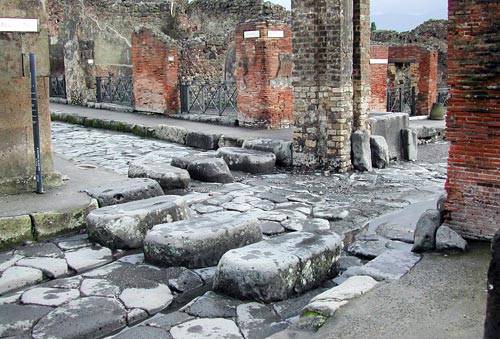
The nearer crossing in the last photo attests to another attribute of this design: note the deep narrow grooves along the road which go through the spaces between the stepping stones. The stones were spaced to the same width as the wheels on a standard cart, allowing wheeled traffic to drive through undisturbed, resulting in the eroded ruts you see in the photo.
The ancient Romans were amazingly like us…
If you want to learn how they lived, you have two options: watch the HBO series (which made an honest effort at historical accuracy), or go visit Pompeii, a lively town frozen in time by that devastating Vesuvian eruption in 79 AD.
I did both, and in Pompeii I snapped this mosaic floor at the street entrance of one of the houses:
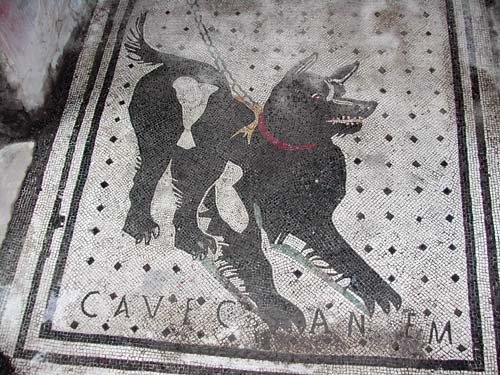
 Nice dog, this one: not too ferocious to allow sympathy, yet substantial enough to scare away thieves. And in case your Latin is rusty, CAVE CANEM means exactly what its modern counterpart in the image at right does (but then, Latin being an important influence in English, you could have identified the words in “Caveat” and “Canine”…)
Nice dog, this one: not too ferocious to allow sympathy, yet substantial enough to scare away thieves. And in case your Latin is rusty, CAVE CANEM means exactly what its modern counterpart in the image at right does (but then, Latin being an important influence in English, you could have identified the words in “Caveat” and “Canine”…)
I was watching 2001: A Space Odyssey again. Such a contrast to today’s special-effect-based space operas… an incredible movie by two giants, and not a bit of CGI in it, either (Sigh…)
Anyway, in the beginning Dr. Heywood arrives at the space station, and is subjected to a “Voice Print Identification” process as he enters a secure area. And it was in this very week that my bank had me record my voice for voice print ID, a new regulatory requirement for phone based transactions in this country.

So, it is 2010, and the futuristic technology that Clarke and Kubrick envisioned in 1968 for use in 2001 is here. Unfortunately, that’s the least interesting prediction of this imaginative movie: we don’t have ubiquitous video telephony (Skype excluded), we don’t have a moon base, we don’t travel to Jupiter, and we don’t have an elegant space station that provides artificial gravity by rotating on its axis.
We do have a space station, true, but it looks like a pile of accreted floating junk… 🙁
Cross-posting this from my Information Overload blog… a look at the original Blackberry from 1998, a winning design with different functionality, different constraints and a quite different usage model from today’s designs. Read all about it here!
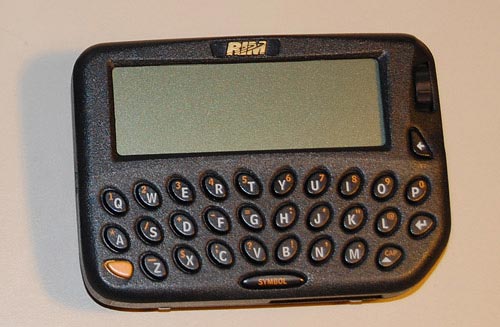
We all know about vestigial organs in living creatures, such as the useless vermiform appendix that gives many people a bad time. These were useful in earlier releases of our body plan, but are now just along for the ride.
So here is a sighting of a similarly useless historical remnant in a Bosch power drill.

I refer to the rubber part affixed to the power cord near the drill’s grip. This well-designed part was very handy in the drills of our youth…
 The intent was to keep the chuck key from getting lost, of course… you could stick it into the hole and the rubber flaps would keep it in place when it wasn’t being used to tighten the chuck. These keys were all too easy to misplace, so this was an excellent solution – as the vermiform appendix used to be when we were all eating leaves before we became humans and learned about chocolate and other delights.
The intent was to keep the chuck key from getting lost, of course… you could stick it into the hole and the rubber flaps would keep it in place when it wasn’t being used to tighten the chuck. These keys were all too easy to misplace, so this was an excellent solution – as the vermiform appendix used to be when we were all eating leaves before we became humans and learned about chocolate and other delights.
The thing is, my drill came with the now common keyless chuck… so the key holder is totally unnecessary. At least it isn’t prone to inflammation…
I was shopping at Office Depot, and next to the checkout line they had this bin full of cheap items on sale. And in it, thrown carelessly with less decorum than potatoes get at the grocer’s, were blister-packaged Flash memory cards.
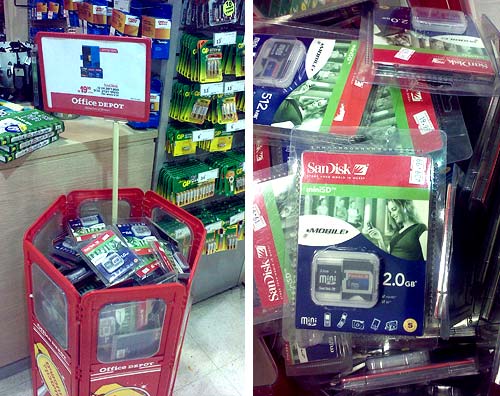
They had 2.0 GB units selling for a pittance. That’s two billion bytes, or 16 Billion bits. I remember Thirty years ago, when a solid state memory board of 16K Bytes would come very carefully packaged – rightly so, as it cost thousands of dollars. The unit in the blister pack shown has a Million times as much capacity and costs 10 bucks. Of course we all know how Moore’s law is driving densities up and price per bit down, but this infamy of selling Gigabytes like peanuts brings it home with some poignancy.
And Below is a similar case, this from our neighborhood general store. Here the Flash Disk-on-key packs are hanging from a shelf alongside Energizer batteries, chocolates, candy and chewing gum packages.
You can bet the core memory stack I show here was not sold with chewing gum…

I was visiting a print design firm and noticed a pile of freshly printed business cards that had the shape of a rectangle with one corner cut off diagonally. I was delighted: this must clearly be the card of some IT professional who wanted to play on the shape of the IBM punched card, right?

Wrong, of course. I asked the designer and he said this is just a nice shape for someone wishing to stand out from the usual rectangular cards, but he didn’t even recognize that this is the form factor of a punched card. In fact, he’d never even seen such a card, even though they were all too common in his parents’ youth – not only in mainframe computer installations but also in every home, since they were used for utility bills to facilitate later data processing (see here). No one who was even slightly literate in the sciences could have missed the similarity back then.
Yet another iconic shape going away into the mists of oblivion…
A while back I was visiting the wonderful Museum of Business History and Technology in Wilmington, Delaware, which has countless typewriters, that incredible device that will soon be completely forgotten. Among these faithful servants of the authors of yesteryear I saw the device in this photo.
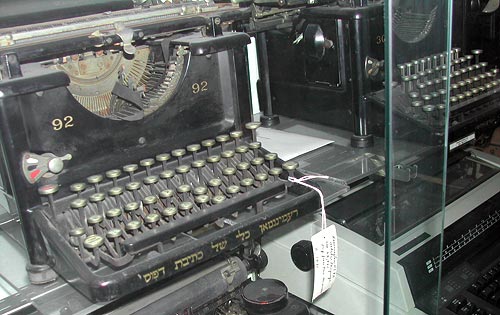
It’s an old Hebrew Remington 92 from around 1930, but what caught my eye was the Hebrew inscription on the frame, which translates literally into “Remington tool of writing type“. Now, the modern Hebrew name for typewriter means literally “writing machine”. And in fact, a little Googling will find you the same old model with this very phrase on it.
So what we’re seeing here is language in the making: the unit in the photo is so early that the term for it hasn’t jelled yet, and different batches were marketed with different names!
Speaking of which, I notice that the name for this machine, in every language I can make out, includes the root “write”, most commonly simply as “writing machine” (machine à écrire, macchina da scrivere, Schreibmaschine, máquina de escribir, etc). Nobody calls it a “printing machine”, even though that’s the immediate action. The important thing is that it is used for writing, in the good old sense that one did with a quill, or a pen, or a pencil, or a piece of chalk. It’s simply an accessory to the creative mind, and all these names – including the discarded one on the Remington 92 above – reflect that fact. Somehow, our computers and keyboards and printers and word processors have lost that linguistic flavor…








 Nice dog, this one: not too ferocious to allow sympathy, yet substantial enough to scare away thieves. And in case your Latin is rusty, CAVE CANEM means exactly what its modern counterpart in the image at right does (but then, Latin being an important influence in English, you could have identified the words in “Caveat” and “Canine”…)
Nice dog, this one: not too ferocious to allow sympathy, yet substantial enough to scare away thieves. And in case your Latin is rusty, CAVE CANEM means exactly what its modern counterpart in the image at right does (but then, Latin being an important influence in English, you could have identified the words in “Caveat” and “Canine”…)


 The intent was to keep the chuck key from getting lost, of course… you could stick it into the hole and the rubber flaps would keep it in place when it wasn’t being used to tighten the chuck. These keys were all too easy to misplace, so this was an excellent solution – as the vermiform appendix used to be when we were all eating leaves before we became humans and learned about chocolate and other delights.
The intent was to keep the chuck key from getting lost, of course… you could stick it into the hole and the rubber flaps would keep it in place when it wasn’t being used to tighten the chuck. These keys were all too easy to misplace, so this was an excellent solution – as the vermiform appendix used to be when we were all eating leaves before we became humans and learned about chocolate and other delights.




